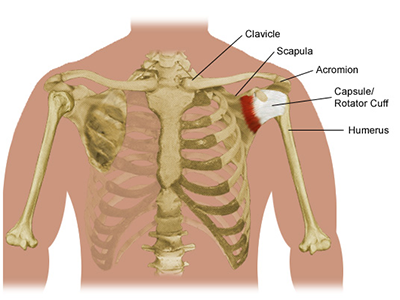Shoulder Dislocation
 What is dislocation of the shoulder?
What is dislocation of the shoulder?
Dislocation of the shoulder means the displacement of the upper arm bone (humerus) out of the shoulder joint. The shoulder joint is the most frequently dislocated major joint of the body - often caused by a significant force that separates the shoulder joint's ball (the top rounded portion of the upper arm bone, or humerus) away from the joint's socket (glenoid). The shoulder can dislocate in several ways, including the following:
- Forward and downward dislocation - these are the most common types of dislocations, usually resulting from falling on an outstretched hand or on the shoulder itself.
- Backward dislocation - a direct blow to the front of the shoulder or the violent twisting of the upper arm may cause this type of dislocation.
In addition, a shoulder can be partially dislocated (the head of the upper arm is partially out of the shoulder socket) or completely dislocated (the head of the upper arm is completely out of the shoulder socket).
A dislocation can result in a fracture of the upper arm bone. Other complications may include the following:
- Nerve damage
- Damage to an artery
- Muscle damage
What are the symptoms of a shoulder dislocation?
The following are the most common symptoms of a dislocated shoulder. However, each individual may experience symptoms differently. Symptoms may include:
- Pain in the upper arm and shoulder, which is usually worse during movement
- Swelling
- Numbness and weakness
- Bruising
- Deformity of the shoulder (in a forward dislocation)
The symptoms of a dislocated shoulder may resemble other conditions or medical problems. Always consult a physician for a diagnosis.
How is a shoulder dislocation diagnosed?
In addition to a complete medical history and physical examination, diagnostic procedures for a dislocated shoulder may include an X-ray (a diagnostic test that uses invisible electromagnetic energy beams to produce images of internal tissues, bones, and organs onto film).
Treatment for a shoulder dislocation
Specific treatment for a shoulder dislocation will be determined by your physician based on:
-
Your age, overall health, and medical history
-
Extent of the injury
-
Your tolerance for specific medications, procedures, or therapies
-
Expectations for the course of the injury
-
Your opinion or preference
Treatment may include:
-
Moving the head of the upper arm bone back into the shoulder joint, usually with an anesthetic
-
Immobilization of the shoulder with a sling
-
Rehabilitation
-
Surgery (if there are complications, such as muscle damage or damage to an artery)